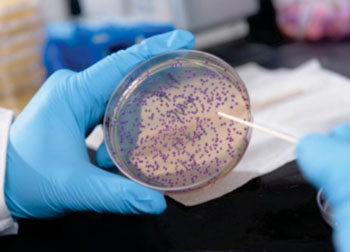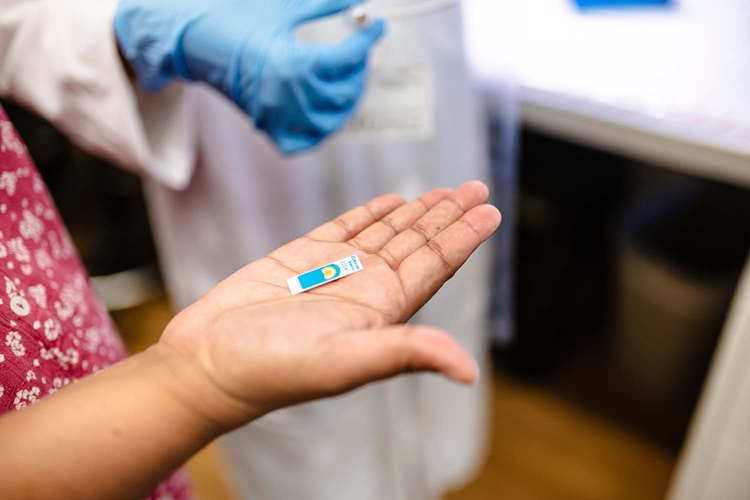Bacteria-Based Biosensor Detects Zinc Deficiency 
|
By LabMedica International staff writers Posted on 14 Sep 2015 |

Image: Plate containing E. coli producing a purple pigment indicative of low levels of zinc. The bacterium could be used to detect nutritional deficiencies in resource-limited areas of the world (Photo courtesy of Rob Felt, Georgia Institute of Technology).
A series of genetic engineering steps led to the development of a bacterial biosensor capable of visually distinguishing levels of zinc, a critical micronutrient.
Micronutrient deficiencies, including zinc deficiency, are responsible for hundreds of thousands of deaths annually. A key obstacle to allocating scarce treatment resources is the ability to measure population blood micronutrient status inexpensively and quickly enough to identify those who most need treatment.
To overcome this obstacle a team of molecular microbiologists at the Georgia Institute of Technology (Atlanta, USA) developed a novel approach for inexpensive screening of micronutrients, with zinc being the test case.
Towards this end, the investigators genetically engineered a strain of Escherichia coli to produce different colored pigments (violacein, lycopene, and beta-carotene) in response to different extracellular zinc levels. Genes for the pigments were taken from other organisms and inserted into the E. coli on a plasmid. The red and orange colors, lycopene and beta-carotene, were produced by genes taken from Pantoea anantis, a plant pathogen. The purple color, violacein, came from a soil bacterium.
Obtaining discrete color states in the carotenoid pathway required precise engineering of the E. coli's metabolism to prevent a reaction at low zinc concentrations but allow complete reaction at higher concentrations, and all under the constraints of the bacterium's natural regulator limitations. A combination of gene dosage, post-transcriptional, and post-translational regulation was necessary to allow visible color change over physiologically relevant ranges representing a small fraction of the regulator’s dynamic response range, with further tuning possible by modulation of precursor availability.
In practice, a pellet of the engineered bacteria was mixed with the plasma from a human subject. The E. coli multiplied, producing the color corresponding to the level of zinc in the sample. Purple corresponded to dangerously low levels, while red indicated borderline levels, and orange normal levels. The color was readily visible without any diagnostic or other electronic equipment.
"We think this is just enough technology to meet the needs," said Dr. Mark Styczynski, assistant professor of chemical and bio-molecular engineering at the Georgia Institute of Technology. "Information we can provide could one day help nutritional epidemiologists and non-governmental organizations determine the populations of people that may need interventions to address nutritional deficiencies."
"The general idea of bio-sensing is certainly out there, but we have taken the step of developing a system that does not require equipment in the field," said Dr. Styczynski. "We believe this will work well in low-resource areas. This is a convincing proof-of-principle, and we hope to begin the translational aspects of this system based on what we have already shown. It is a matter now of reducing this to practice for something that will ultimately be useful."
The novel assay for zinc deficiency was described in a paper published in the September 2015 issue of the journal Metabolic Engineering.
Related Links:
Georgia Institute of Technology
Micronutrient deficiencies, including zinc deficiency, are responsible for hundreds of thousands of deaths annually. A key obstacle to allocating scarce treatment resources is the ability to measure population blood micronutrient status inexpensively and quickly enough to identify those who most need treatment.
To overcome this obstacle a team of molecular microbiologists at the Georgia Institute of Technology (Atlanta, USA) developed a novel approach for inexpensive screening of micronutrients, with zinc being the test case.
Towards this end, the investigators genetically engineered a strain of Escherichia coli to produce different colored pigments (violacein, lycopene, and beta-carotene) in response to different extracellular zinc levels. Genes for the pigments were taken from other organisms and inserted into the E. coli on a plasmid. The red and orange colors, lycopene and beta-carotene, were produced by genes taken from Pantoea anantis, a plant pathogen. The purple color, violacein, came from a soil bacterium.
Obtaining discrete color states in the carotenoid pathway required precise engineering of the E. coli's metabolism to prevent a reaction at low zinc concentrations but allow complete reaction at higher concentrations, and all under the constraints of the bacterium's natural regulator limitations. A combination of gene dosage, post-transcriptional, and post-translational regulation was necessary to allow visible color change over physiologically relevant ranges representing a small fraction of the regulator’s dynamic response range, with further tuning possible by modulation of precursor availability.
In practice, a pellet of the engineered bacteria was mixed with the plasma from a human subject. The E. coli multiplied, producing the color corresponding to the level of zinc in the sample. Purple corresponded to dangerously low levels, while red indicated borderline levels, and orange normal levels. The color was readily visible without any diagnostic or other electronic equipment.
"We think this is just enough technology to meet the needs," said Dr. Mark Styczynski, assistant professor of chemical and bio-molecular engineering at the Georgia Institute of Technology. "Information we can provide could one day help nutritional epidemiologists and non-governmental organizations determine the populations of people that may need interventions to address nutritional deficiencies."
"The general idea of bio-sensing is certainly out there, but we have taken the step of developing a system that does not require equipment in the field," said Dr. Styczynski. "We believe this will work well in low-resource areas. This is a convincing proof-of-principle, and we hope to begin the translational aspects of this system based on what we have already shown. It is a matter now of reducing this to practice for something that will ultimately be useful."
The novel assay for zinc deficiency was described in a paper published in the September 2015 issue of the journal Metabolic Engineering.
Related Links:
Georgia Institute of Technology
Latest BioResearch News
- Genome Analysis Predicts Likelihood of Neurodisability in Oxygen-Deprived Newborns
- Gene Panel Predicts Disease Progession for Patients with B-cell Lymphoma
- New Method Simplifies Preparation of Tumor Genomic DNA Libraries
- New Tool Developed for Diagnosis of Chronic HBV Infection
- Panel of Genetic Loci Accurately Predicts Risk of Developing Gout
- Disrupted TGFB Signaling Linked to Increased Cancer-Related Bacteria
- Gene Fusion Protein Proposed as Prostate Cancer Biomarker
- NIV Test to Diagnose and Monitor Vascular Complications in Diabetes
- Semen Exosome MicroRNA Proves Biomarker for Prostate Cancer
- Genetic Loci Link Plasma Lipid Levels to CVD Risk
- Newly Identified Gene Network Aids in Early Diagnosis of Autism Spectrum Disorder
- Link Confirmed between Living in Poverty and Developing Diseases
- Genomic Study Identifies Kidney Disease Loci in Type I Diabetes Patients
- Liquid Biopsy More Effective for Analyzing Tumor Drug Resistance Mutations
- New Liquid Biopsy Assay Reveals Host-Pathogen Interactions
- Method Developed for Enriching Trophoblast Population in Samples
Channels
Clinical Chemistry
view channel
POC Breath Diagnostic System to Detect Pneumonia-Causing Pathogens
Pseudomonas aeruginosa is a major cause of hospital-acquired and ventilator-associated pneumonia, particularly in lung transplant recipients and patients with structural lung disease. Its ability to form... Read more
Online Tool Detects Drug Exposure Directly from Patient Samples
Doctors often rely on patient interviews and medical records to determine what medications a person has taken, but this information is frequently incomplete. People may forget drugs they used, take over-the-counter... Read moreMolecular Diagnostics
view channel
DNA Detection Platform Enables Real-Time Molecular Detection
A next-gen DNA detection platform enables real-time molecular detection by detecting nucleic acids directly without enzymes or thermocyclers, thereby slashing costs, reducing complexity, and boosting reliability... Read more
STI Molecular Test Delivers Rapid POC Results for Treatment Guidance
An affordable, rapid molecular diagnostic for sexually transmitted infections (STIs) has the potential to be globally relevant, particularly in resource-limited settings where rapid, point-of-care results... Read moreHematology
view channel
MRD Tests Could Predict Survival in Leukemia Patients
Acute myeloid leukemia is an aggressive blood cancer that disrupts normal blood cell production and often relapses even after intensive treatment. Clinicians currently lack early, reliable markers to predict... Read more
Platelet Activity Blood Test in Middle Age Could Identify Early Alzheimer’s Risk
Early detection of Alzheimer’s disease remains one of the biggest unmet needs in neurology, particularly because the biological changes underlying the disorder begin decades before memory symptoms appear.... Read more
Microvesicles Measurement Could Detect Vascular Injury in Sickle Cell Disease Patients
Assessing disease severity in sickle cell disease (SCD) remains challenging, especially when trying to predict hemolysis, vascular injury, and risk of complications such as vaso-occlusive crises.... Read more
ADLM’s New Coagulation Testing Guidance to Improve Care for Patients on Blood Thinners
Direct oral anticoagulants (DOACs) are one of the most common types of blood thinners. Patients take them to prevent a host of complications that could arise from blood clotting, including stroke, deep... Read moreImmunology
view channel
Blood Test Could Identify Colon Cancer Patients to Benefit from NSAIDs
Colon cancer remains a major cause of cancer-related illness, with many patients facing relapse even after surgery and chemotherapy. Up to 40% of people with stage III disease experience recurrence, highlighting... Read moreBlood Test Could Detect Adverse Immunotherapy Effects
Immune checkpoint inhibitors have transformed cancer treatment, but they can also trigger serious immune-related adverse events that damage healthy organs and may become life-threatening if not detected early.... Read moreMicrobiology
view channel
Breakthroughs in Microbial Analysis to Enhance Disease Prediction
Microorganisms shape human health, ecosystems, and the planet’s climate, yet identifying them and understanding how they are related remains a major scientific challenge. Even with modern DNA sequencing,... Read more
Blood-Based Diagnostic Method Could Identify Pediatric LRTIs
Lower-respiratory tract infections (LRTIs) are a leading cause of illness and death worldwide, and pneumonia is the leading infectious cause of death in children under five, claiming the lives of over... Read morePathology
view channel
Rapid Low-Cost Tests Can Prevent Child Deaths from Contaminated Medicinal Syrups
Medicinal syrups contaminated with toxic chemicals have caused the deaths of hundreds of children worldwide, exposing a critical gap in how these products are tested before reaching patients.... Read more
Tumor Signals in Saliva and Blood Enable Non-Invasive Monitoring of Head and Neck Cancer
Head and neck cancers are among the most aggressive malignancies worldwide, with nearly 900,000 new cases diagnosed each year. Monitoring these cancers for recurrence or relapse typically relies on tissue... Read more
Common Health Issues Can Influence New Blood Tests for Alzheimer’s Disease
Blood-based tests for Alzheimer’s disease are transforming diagnosis by offering a simpler alternative to spinal taps and brain imaging. However, many people evaluated at memory clinics also live with... Read more
Blood Test Formula Identifies Chronic Liver Disease Patients with Higher Cancer Risk
Chronic liver disease affects millions worldwide and can progress silently to hepatocellular carcinoma (HCC), one of the deadliest cancers globally. While surveillance guidelines exist for patients with... Read moreTechnology
view channel
Machine Learning Models Diagnose ALS Earlier Through Blood Biomarkers
Amyotrophic lateral sclerosis (ALS) is a rapidly progressive neurodegenerative disease that is notoriously difficult to diagnose in its early stages. Early symptoms often overlap with other neurological... Read more
Artificial Intelligence Model Could Accelerate Rare Disease Diagnosis
Identifying which genetic variants actually cause disease remains one of the biggest challenges in genomic medicine. Each person carries tens of thousands of DNA changes, yet only a few meaningfully alter... Read moreIndustry
view channel
BD and Penn Institute Collaborate to Advance Immunotherapy through Flow Cytometry
BD (Becton, Dickinson and Company, Franklin Lakes, NJ, USA) has entered into a strategic collaboration with the Institute for Immunology and Immune Health (I3H, Philadelphia, PA, USA) at the University... Read more




 assay.jpg)

















